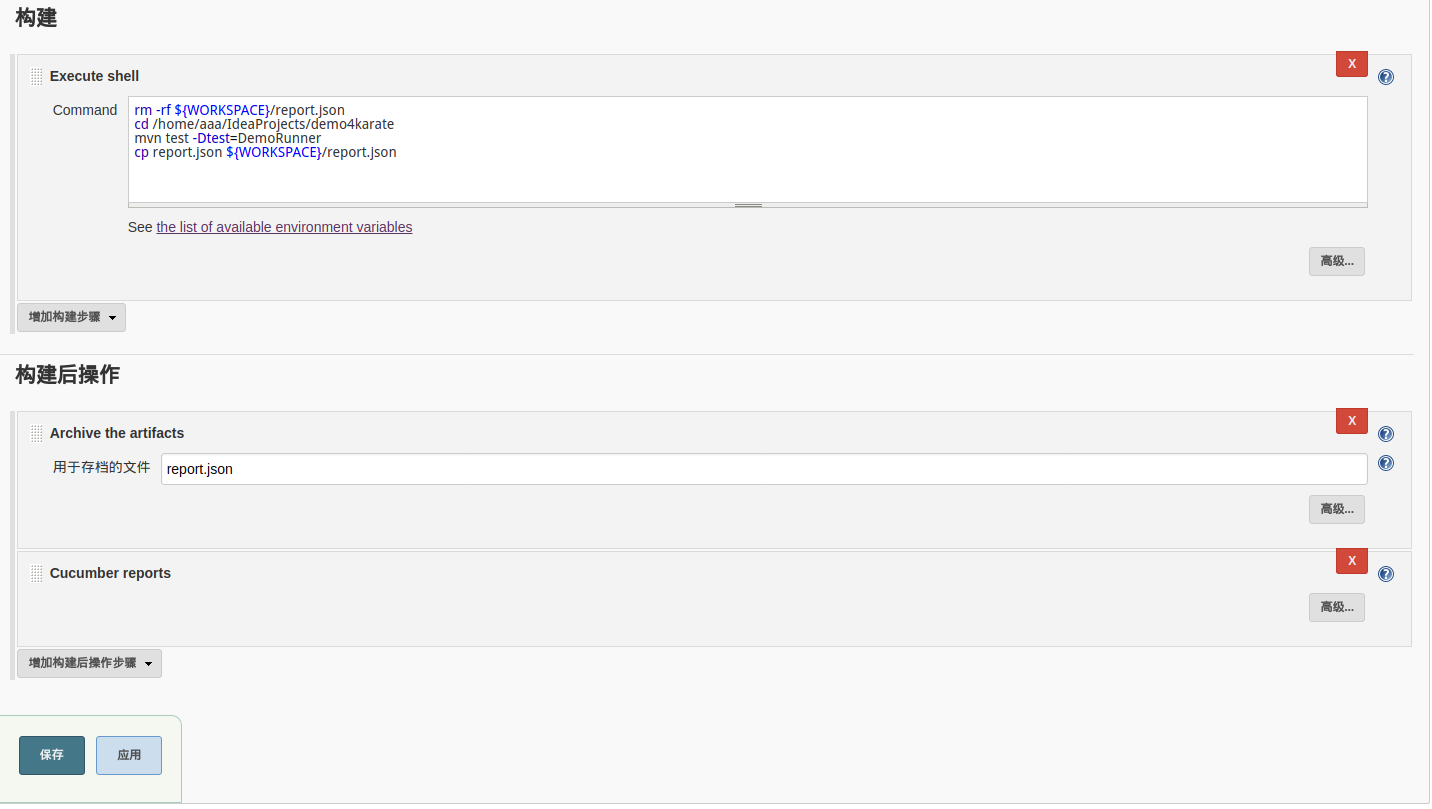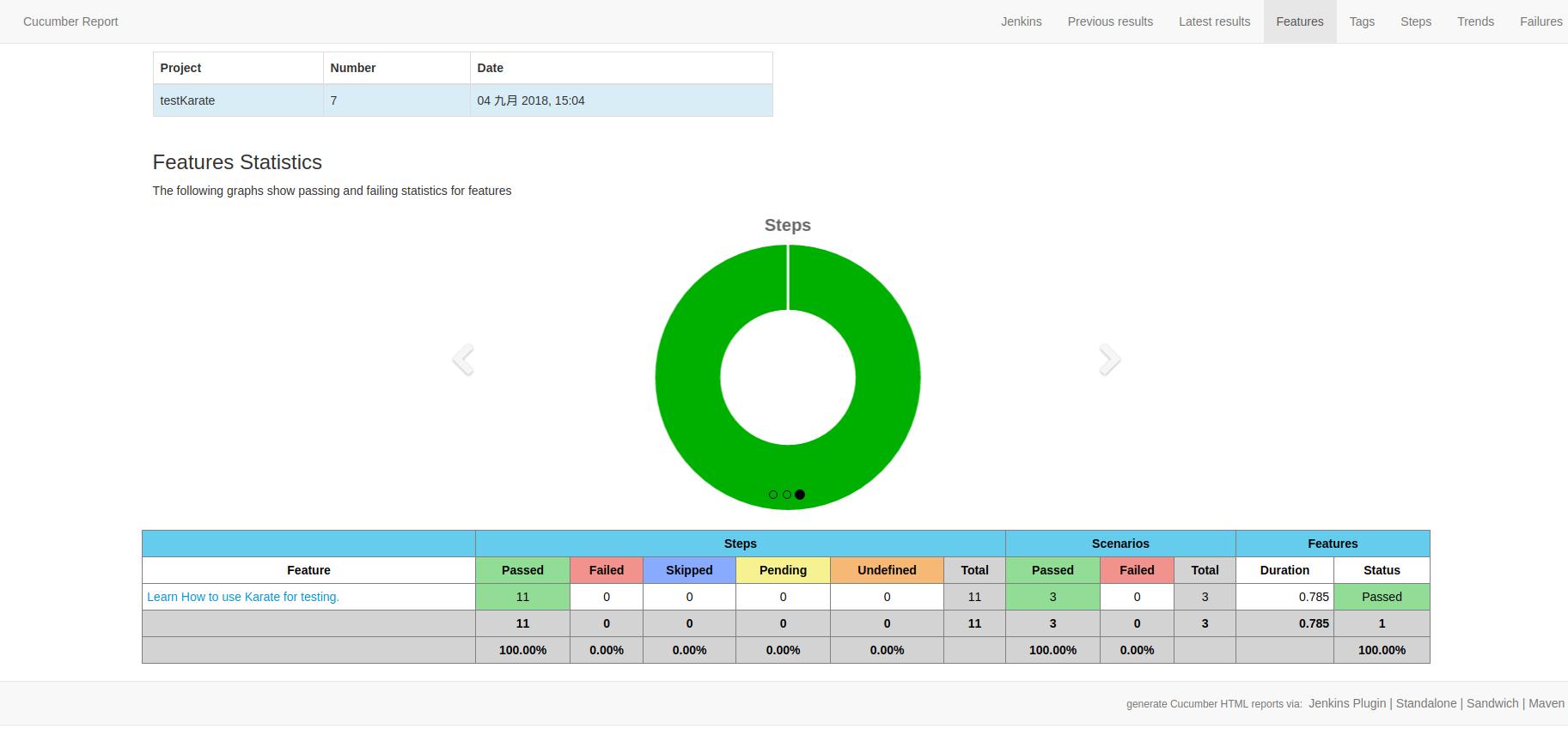https://www.cnblogs.com/ouguangqian/p/karate_learn.html涉及的代码
在这篇文章中,我们将介绍一下开源的Web-API自动化测试框架——Karate Karate是基于另一个BDD测试框架Cucumber来建立的,并且共用了一些相同的思想。其中之一就是使用Gherkin文件,该文件描述了被测试的功能 与Cucumber不同的是测试用例不需要用Java编写,并且被完整的描述在Gherkin文件中 通过Karate,您可以编写任何类型的Web服务端的测试脚本,并检查响应是否符合预期 Karate的验证引擎可以灵活的比较两个JSON或XML文件内容,不受空格和数据顺序的影响 有关Karate的更详细的内容,请参考Karate官方介绍
- 建立在Cucumber-JVM基础上
- 可以像标准的Java工程一样运行测试并且产生报告
- 测试代码的开发不需要掌握任何的Java知识
- 即使对非编程人员,测试代码也很容易编写
- JDK1.8及以上
- Maven
- IDEA
要在Maven项目中使用Karate,需要将karate-apache依赖项添加到pom.xml,如果实现JUnit测试还需要添加karate-junit4依赖
<dependencies>
<dependency>
<groupId>com.intuit.karate</groupId>
<artifactId>karate-apache</artifactId>
<version>0.8.0</version>
<scope>test</scope>
</dependency>
<dependency>
<groupId>com.intuit.karate</groupId>
<artifactId>karate-junit4</artifactId>
<version>0.8.0</version>
<scope>test</scope>
</dependency>
</dependencies>
设置测试资源文件目录,建议测试用例文件和java文件放在同一个目录下,遇到庞大的工程的时候方便管理,不必在文件夹src/test/java和src/test/resources文件夹之间切换,可以在pom.xml的标签中添加一下设置
<testResources>
<testResource>
<directory>src/test/java</directory>
<excludes>
<exclude>**/*.java</exclude>
</excludes>
</testResource>
</testResources>
为了演示REST API,我们使用WireMock服务器 在pom.xml中添加mock服务依赖配置
<dependency>
<groupId>com.github.tomakehurst</groupId>
<artifactId>wiremock-standalone</artifactId>
<version>2.18.0</version>
<scope>test</scope>
</dependency>
编写一个启动服务的类
package server;
import com.github.tomakehurst.wiremock.WireMockServer;
import static com.github.tomakehurst.wiremock.client.WireMock.*;
public class StartServer {
private static WireMockServer wireMockServer = new WireMockServer(8080);
public static void startServer(){
wireMockServer.start();
stubFor(
get(urlEqualTo("/user/get"))
.willReturn(aResponse()
.withStatus(200)
.withHeader("Content-Type", "application/json")
.withBody("{ \"id\": \"1234\", name: \"John Smith\" }")));
stubFor(
post(urlEqualTo("/user/create"))
.withHeader("content-type", equalTo("application/json"))
.withRequestBody(containing("id"))
.willReturn(aResponse()
.withStatus(200)
.withHeader("Content-Type", "application/json")
.withBody("{ \"id\": \"1234\", name: \"John Smith\" }")));
}
public static void main(String... args){
startServer();
}
}一个用例文件以“ .feature”扩展名保存。 文件以Feature关键字开头,在同一行跟着所测试的功能名称 一个用例文件包含不同的测试场景,每个场景都以关键字Scenario开头,并且包含多个步骤。这些步骤包含关键字Given,When,Then,And和But 有关Cucumber和Gherkin结构的更多信息,请点击此处
Feature: Learn How to use Karate for testing.
Scenario: Testing valid GET endpoint
Given url 'http://localhost:8080/user/get'
When method GET
Then status 200
Scenario: Testing the exact response of a GET endpoint
Given url 'http://localhost:8080/user/get'
When method GET
Then status 200
And match $ == {id:"1234", name:"John Smith"}
Scenario: Testing that GET response contains specific field
Given url 'http://localhost:8080/user/get'
When method GET
Then status 200
And match $ contains {id:"1234"}
建议放在用例文件同级目录下 我们可以通过将Karate与JUnit集成来运行我们的测试 我们将使用@CucumberOptions注解指定Feature文件的具体位置
package demo;
import com.intuit.karate.junit4.Karate;
import cucumber.api.CucumberOptions;
import org.junit.runner.RunWith;
@RunWith(Karate.class)
@CucumberOptions(features = "classpath:demo/demo.feature")
public class DemoRunner {
}在项目的target/surfire-reports目录下有TEST-demo.demo.html文件,浏览器中打开即可看到结果
可以借助于jenkins完成自动化测试并且jenkins提供插件cucumber-reports可以展示可读性强的自动化测试报告 需要修改Runner继承KarateRunner,先引入Karate-testng依赖
<dependency>
<groupId>com.intuit.karate</groupId>
<artifactId>karate-testng</artifactId>
<version>0.8.0</version>
</dependency>
修改DemoRunner,注意配置CucumberOptions,要产生json格式的报告,cucumber-reports插件会去解析该文件并生成报告
package demo;
import com.intuit.karate.junit4.Karate;
import com.intuit.karate.testng.KarateRunner;
import cucumber.api.CucumberOptions;
import org.junit.runner.RunWith;
@CucumberOptions(features = "classpath:demo/demo.feature",format={"pretty","html:reports","json:report.json"})
public class DemoRunner extends KarateRunner {
}jenkins中cucumber-reports配置请参考网络资源 jenkins配置命令行运行指令
rm -rf
${WORKSPACE}/report.json cd /home/pateo/IdeaProjects/demo4karate mvn test -Dtest=DemoRunner cp report.json $ {WORKSPACE}/report.json







